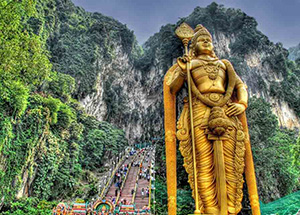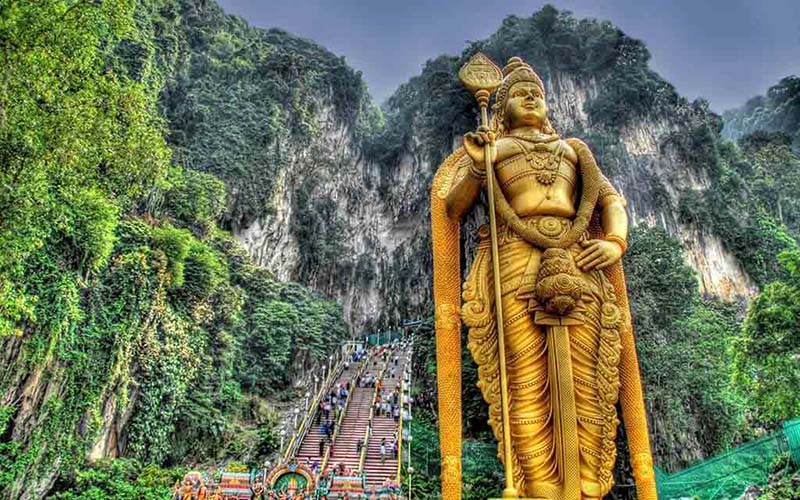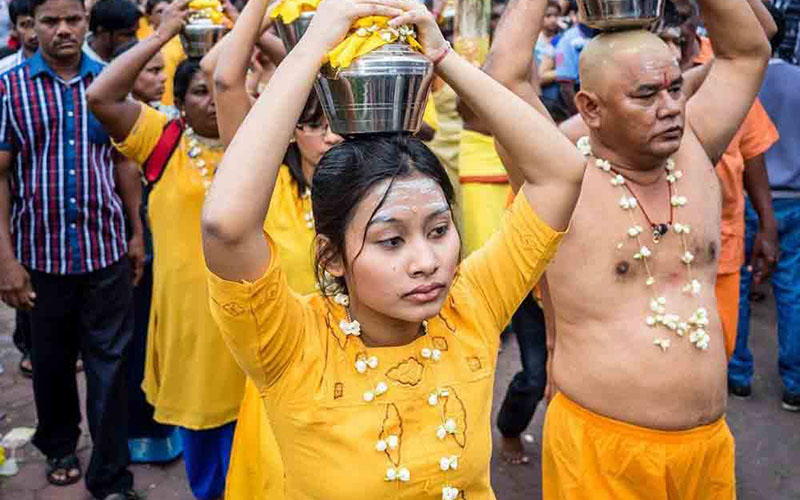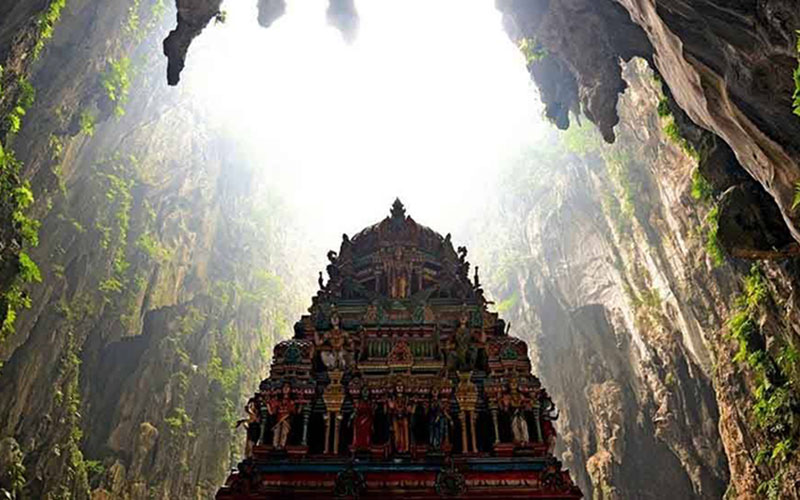There are a lot of attractions in Malaysia that is known throughout the world. It’s the capital city of Kuala Lumpur that attracts millions of visitors every year for the plethora of shopping opportunities, amazing attractions, diverse culture, and the Batu Caves. For those very few, unfamiliar with the Batu Caves temple in Malaysia, here’s everything you need to know about this incredible place.
The Batu Temple and Cave
Named after the Sungai Batu river flowing past the hill, the Batu Caves is a series of cave temples and caves on a limestone hill. There is also a village by the name Batu that is nearby the hills. The Batu cave temple is dedicated to Lord Murugan, the Hindu deity, and is one of the most popular Hindu shrines outside India.
At the base of the hill, there are two cave temples- a Museum cave, and an Art Gallery cave that contains paintings and statues of Hindu deities. The Murugan temple in Batu Caves is managed by the Board of Management of Shri Mariamman Temple Devastanam that manages other important Hindu temples in Malaysia and also is a Hindu Religious Consultant body to the Government of Malaysia.
To the extreme left is another cave, The Ramayana Cave. On the way to the Ramayana cave, you will see a tall statue of Hanuman, the monkey aide of the deity Ram. The Ramayana cave depicts the story of the deity Ram along the walls of the cave.
Batu Caves Timings
All Day: 6 AM – 9 PM
Entrance fee: Free
How to Reach Batu Caves
There’s a special station called the Batu Caves Komuter Station that brings a commuter train from the Kuala Lumpur Central. It costs around 3.6 RM for a one-way ticket to reach the Batu Caves from Kuala Lumpur. Special Bus services are also available from Bangkok terminus. You can also reach Btu Caves by road.
Where to Eat at Batu Caves
There is no argument to saying that the temple is popular amongst both the locals and tourists. And people in millions arrive at this spellbinding spot. Since you would be spending a long day here, you would look out for a plate of warm and luscious food that could satiate your hunger. You are going to love this- to refuel your appetite and find energy while touring this huge place, there is an array of restaurants in Batu Caves. Admire the charisma of nature and savor the delicious meal like Chinese cuisine, seafood and vegetarian delights with great flavors cooked in freshest ingredients. Curry Mee and Sang Har Hor Fun are the highlights.
To unwind and eat, stop by:
- Restoran Pan Heong,
- Hang Wan,
- Bamboos Thai Cafe
- Coca Seafood Restaurant
- Canton Kitchen
The History Of Batu Caves
Dating back to 400 million years, Batu Caves is located 13 kilometers to the north of Kuala Lumpur. The 400 meters long and 100 meters high caves were discovered in 1872 but became popular after the Indian trader Thamboosamy Pillai saw the cave and installed a statue of Lord Murugan in it in the year 1890. Initially, wooden steps were built to reach this temple cave which has now been replaced with 272 concrete steps. A series of caves some small and some bigger, the largest is the famous temple cave as it houses numerous Hindu shrines.
Batu Caves is also the center of Rock Climbing development for the past 10 years in Malaysia. It offers more than 160 climbing paths. People fond of spelunking can avail services of companies that offer educational trips to the caves and also provide all the equipment for such an adventure.
You can find many monkeys at the temple which are fed peanuts by visitors. There are vendors who specially sell these at the base of the hill. The Hindu deity Hanuman is believed to be a monkey and that is why no monkey is harmed at the place. You can click pics of these monkeys and watch the crowd worshipping, feeding, and playing with them too.
The festival of Thaipusam celebrated by Hindus has its focal point here. Every year for this festival as many as 8 lakh visitors throng the caves. The procession starts from the Mahamariamman temple in Kuala Lumpur and lasts for around eight hours. The devotees carry pitchers of milk as an offering to the Lord Murugan either on hand or on shoulders in kavadi (wooden carriers decorated with peacock feathers imported from India). After taking a refreshing dip in the Batu River, the devotees climb the fleet of stairs to visit the temple in Batu cave.
While the devotees take the wider staircase at the center, the onlookers take the balustrades on either side. You will also see devotees getting their backs pierced as a form of penance. While removing the hooks, the priests ensure that blood is not shed by sprinkling ash. It might sound strange but it is a sight to witness if you’re there during the festival. The atmosphere is electrifying and you definitely don’t want to miss the festival if you’re in Kuala Lumpur during that time.
Since the year 1970, housing development projects began and the small village surrounding the caves changed to an industrial estate with new houses and shops. Although this move has made the area more commercialized it also has made it extremely convenient for the tourists.
The Batu Cave Facts
- The iconic statue of Lord Murugan at the start of the cave is a whopping 43 meters high, constructed of 1550 cubic meters of concrete and 250 tons of steel bars. All the material for its creation was brought from Thailand.
- The statue of Lord Murugan is painted with 300 liters of gold paint and it shines very brightly when the sun is up. It is the tallest statue of Lord Murugan in the world.
- To reach the cave a fleet of 272 steps has to be climbed and there’s no other way. The management gives restricted access to the visitors in order to maintain the ecology of the cave with rock formations formed over thousands of years.
- The Batu caves are home to vibrant fauna with Liphistiidae spiders and Eonycteris and fruit bats. These are some of the unique species in the world.
Sights and Activities at Batu Caves
Batu Caves has 4 attractions in its compound, including 3 major caves, which are believed to be hundreds of millions of years old. Explore the details here:
- Temple Cave (Cathedral Cave)
The focal point of the Batu Caves is the Temple Cave that sits atop the mountain and can be accessed only if you take the 272 stairs. When you reach the final step, you will be stunned by the massive height of the cave, which is guarded by the Hindu deity Lord Murugan’s 43-meter high gold statue. The cave is a composition of two caverns, both are joined through the flight of steps. One cavern has the Murugan’s six abodes while the other is the temple of the Valli Devanai, Murugan’s wife. The place is swarmed by the monkeys. You can attend prayers at 8.30am and 4.30pm. In the end, you can go ahead and contribute willingly to the donation box.
Entry fee: Free
- Dark Cave
When you are in halfway to climbing up the stairs, you will be left curious by the unique Dark Cave. It is home to unexpected creatures like trapdoor spiders, bats, and flatworms and can be explored only with a guide by the side. He will take you to the 45-minute educational tour through the limestone passageway into the 7 different chambers. It is exciting, intriguing and engulfing to inform yourself of such an unusual animal community- see the rarest spider dating back to 100 million years, learn about 10 species of bat and find mind-blowing facts about several other organisms. If you dare your guts, you can go deep into the cave, with the adventure tour of 3-4 hours.
Educational Tour Fee: 35RM for adults, 25RM for children
- Ramayan Cave
As you spot the tall, green statue of Hanuman, hop onto the bridge, you will find an entrance to another of the prestigious cave. Temple Cave is popular but no cave has been adorned like the Ramayan Cave. It takes you into the epic story of Ramayana with the colorful statues of the god and devil and dynamic lighting. While strolling around, the sculptures and staging will depict the entire story graciously. The giant sleeping figure of Kumbhakaran, brother of Raavan (slept for 6 months and had to be woken up with drums and arrows) takes the attention of children.
Entry Fee: 5RM for adults, free for children
- Cave Villa
If listening to the fact that you have to climb so much, your knee hurts, or if thinking about the creepy spiders, you feel hesitant, this last attraction would inspire you. The Cave Villa is tucked at the foot of the limestone hill and people reach through the twisted bridge. Inside the caves, you will be fascinated by Hindu poems, readings, paintings and more. Besides the wisdom section, you can also find the transparent tanks having snakes and other reptiles.
- Rock Climbing
Looking to boost your adrenaline? Since this limestone outcrop is incredibly high and has rugged terrain, the adventure seekers have made it the ultimate hub of rock climbing. There are routes for beginners to experience climbers letting you have one of the most thrilling experiences in Malaysia.
Events and Festivals at Batu Caves
The Batu Cave is prominently visited for embarking the celebration of one of the most pious Hindu festivals, Thaipusam. Malaysia is rich in culture, with population involving Islam, Buddhism, Hinduism, and Christianity. Amongst many vibrant and religious festivals, Thaipusam is known for its grandeur and crowd.
It is an annual celebration held in January and February, in the honor of the Hindu god Subramanian. The date swings according to when the moon appears in the Thai month of the Tamil calendar. The rituals and festivities are conducted on the Batu Caves.
The festival is to mark these two significant events:
- The birth of the god Murugan, the youngest son of God Shiva and Parvati.
- The defeat of evil Soorapadmandemon by god Murugan’s lance gifted by God Parvati.
Millions of followers and devotees flock to the limestone cave and join the magnificent parade. At the foot of the hills, you can discover a massive gathering which then ascends the top of the mountain through 272 stairs. Inside the caves are beautifully crafted Hindu gods and the granite-carved statue of Lord Subramanian.
The procession of carrying the statue of the deity in a golden chariot is started in the wee hours of the morning, from the oldest temple Sri Mahamariamman Temple. Hundreds of believers revel in the spirit, carrying the ‘kavadis’ decorated with flowers and peacock feathers, and reach the Batu Cave by noon where the main proceedings begin like bathing the statue in the river, performing prayers and singing the rhythm with drums. The offerings and prayer continue for the next two days, making it one of the most colorful and busy days.
Book Now: Malaysia Tourist Visa Online
FAQs
Q1. What are Batu Caves?
Batu Caves are a range of limestone caves and cave temples located in Gombak, Selangor, Malaysia. They are one of the most popular tourist attractions in Kuala Lumpur and are considered a sacred site by Hindus.
Q2. What are the key attractions in Batu Caves?
- Art Gallery Cave
- The Dark Cave
- The Cathedral Cave
- Lord Murugan
Q3. Name some good places to eat in Batu Caves.
- Hang Wan
- Canton Kitchen
- Bamboos Thai Café
Q4. What is Thaipusam?
It is a pious Hindu festival celebrated in January & February to honor God Subramanian. It is celebrated in the Batu Caves.
Q5. Is Batu Caves safe to visit?
Yes it is safe to visit. However, it is always advisable to exercise caution and keep an eye on the belongings, especially in crowded areas.





The inside of the cave where the temple is looks great. I would love to be there someday.
Nice to know about the Taipoosam festivities that take place there. Looks like that’s a great time to be there.